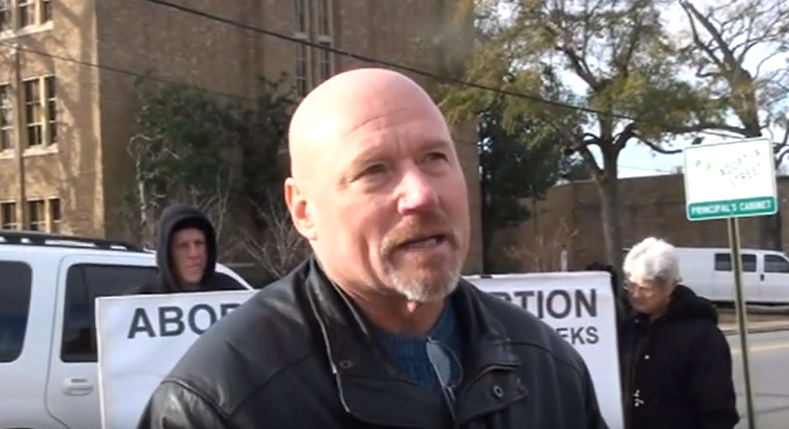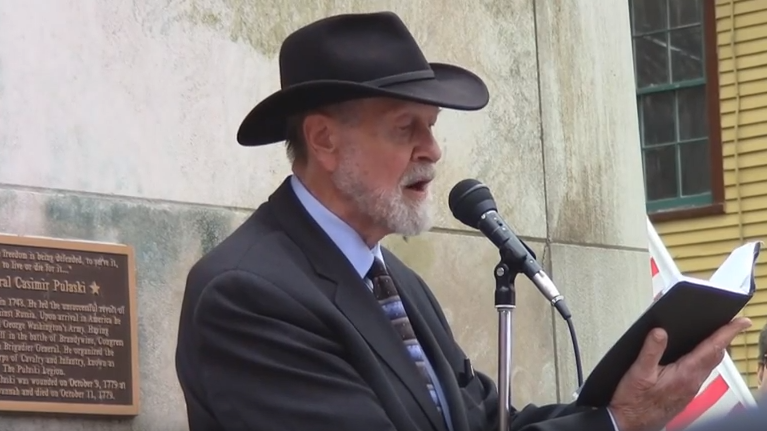A ProPublica investigation published in the Washington Post today looks at the sophisticated data collection methods used by abortion-clinic protesters to gather information about abortion providers, which has occasionally led to the identities of abortion patients being publicly exposed against their will.
“In recent years, abortion opponents have become experts at accessing public records such as recordings of 911 calls, autopsy reports, and documents from state health departments and medical boards, then publishing the information on their Web sites,” writes ProPublica’s Charles Ornstein. “Some activists have dug through clinics’ trash to find privacy violations by abortion providers — such as patient records tossed in dumpsters — and used them to file complaints with regulators.”
Aggressive data collection about abortion providers and patients, often by the same people serving as “sidewalk counselors” for anti-abortion groups, has become a hallmark of the anti-choice “rescue” movement since the advent of laws preventing activists from literally blocking the doors to clinics. The de facto leader of this movement is Operation Rescue’s Troy Newman, who has been in the news recently as the patron of a series of “sting” videos smearing Planned Parenthood.
Ornstein writes that these activists “appear to be drawing from an unofficial playbook: Some wait outside clinics, tracking or taking photos of patients’ and staffers’ license plates and ambulances, if called.”
A version of that “informal playbook” was put into writing last year by Newman and his Operation Rescue colleague Cheryl Sullenger in their book “Abortion Free: Your Manual for Building a Pro-Life America One Community at a Time,” published by the far-right outlet WorldNetDaily.
In it, Newman and Sullenger (who says she has embraced nonviolence after serving time in jail for conspiring to bomb a California abortion clinic in the 1980s) outline for anti-choice activists how they can collect information on abortion providers, make it public, and use it to try to drive providers out of business and convince legislators to try to do the same.
Newman and Sullenger review various tactics for anti-choice activists looking to gather information on abortion providers, including public records requests, sting operations like the one behind the recent Planned Parenthood videos, and collecting information on vendors who work with abortion providers in order to harass them into ending their association.
“Make a record of all the vendors you can, and photograph their vehicles, especially if they bear the company logos,” Sullenger and Newman counsel, adding that protesters should “keep a camera and a notepad” with them at all times.
Newman and Sullenger tell protesters to aggressively take photographs or video whenever they witness a patient being transferred to a hospital as a result of complications.
They proudly tell how once while standing outside the Wichita clinic of George Tiller — who was later murdered by an anti-abortion extremist — they saw Tiller escort a woman who had suffered a complication to the emergency room. The anti-abortion activists took pictures of the woman, which they then printed on postcards that they mailed to the neighbors of employees of Tiller’s clinic:
We enlarged the pictures of Tiller wheeling the injured woman into the emergency room, plastered them on the sides of our Truth Truck, and parked it out in front of his clinic driveway gate, where it aided in turning many women away from having abortions out of concern that they might be next. We put the photos on postcards and sent them to every legislator, asking for laws to protect women, which helped push forward pro-life legislation. We sent the images to the neighbors of abortion clinic workers, asking them to pray for their neighbor to leave the abortion industry, which prompted several workers to quit their jobs at Tiller’s clinic.
“Photos that show the victim on a gurney being taken from the abortion clinic are useful and dramatic,” the activists write in a list of tips for sidewalk counselors. “Submit a FOIA request for the 911 audio file and CAD transcript of the call as soon as possible,” they add.
“Don’t be worried about compromising a patient’s privacy when taking photos, because faces can be blurred using editing software before they are published,” they advise.
Newman and Sullenger tell of how, in an effort to find the identity of a new doctor Tiller had hired, they pieced together the pieces of a private medical form discarded by a patient:
A woman had tossed torn-up pieces of paper out her window before driving away from the abortion clinic. The sidewalk counselor had retrieved them and gave them to us. We pieced them together and discovered the initials S.R. on a line that required a physician’s signature.
Although Newman and Sullenger never advocate deliberately exposing the identities of abortion patients, that is certainly not the case for providers, whose names, address and photographs they catalogue on their website AbortionDocs.com. In their book, they urge activists to dig up whatever dirt they can on providers, even when it’s completely irrelevant to their medical practice.
They tell, for instance, of finding a “ridiculous” photo of an abortion clinic administrator on social media that showed the “bleached blonde” with her “dark roots embarrassingly showing,” which they made a point of using “repeatedly” on their website:
Search social networking sites such as Facebook, Twitter and LinkedIn. Sometimes very interesting insight can be garnered from their social network profiles, including photos of the abortionists doing crazy things. For example, the administrator of an abortion chain in Texas left her social profile public, and we found a ridiculous photo of the bleached blonde — dark roots embarrassingly showing — making a silly face while peering through a curtain of plastic grass. That picture made her look like anything but the serious medical professional she purported herself to be. We have used the photo repeatedly on our own website.
Newman and Sullenger also provide guidance for “stings” such as that conducted by David Daleiden of the Center for Medical Progress, for whom Newman seems to have served as a mentor and funder. Starting the chapter of their book with a quote from Sun Tzu, “All warfare is based on deception,” they offer a biblical justification for using false identities to investigate a “godless enemy”:
Some have no problem whatsoever stretching the truth to a godless enemy who is bent on destroying innocent lives — especially if it can be used to save babies. One need only look at the story of Rahab in the Bible for an example of a woman who used misdirection to save the lives of the Jewish spies and was honored by God for it (See Joshua 2).
Groups like Operation Rescue serve as an important part of the anti-choice movement’s effort to chip away at abortion access by regulating providers out of existence. While large, politically influential groups like Americans United for Life advocate for laws that place unnecessary regulatory constraints on abortion providers, groups like Operation Rescue look for any small violation that they can use to attack the clinic.
Although activists often say they are seeking to find gross mismanagement and abuses like those at Philadelphia abortion provider Kermit Gosnell’s clinic in Philadelphia, Newman and Sullenger tell activists that no violation is too small to be used against a clinic. They urge protesters to look for minor violations of zoning codes, like insufficient parking or improper signage. If you look hard enough, they say, you’ll eventually find something:
In all our combined decades of experience, we have yet to find an abortion business that abides by all applicable laws. That means every abortion clinic is legally vulnerable and subject to closure. Our job is to find out what the abortionists are doing wrong and exploit their weaknesses.
They urge activists to simultaneously encourage their elected officials to “whittle away” at abortion access by implementing “regulations and laws that essentially make it impossible for abortion mills to operate”:
Some pro-life groups believe that an all-or-nothing approach is the way to go. They won’t support any legislation — and in some cases will block it — if it doesn’t ban abortions outright. We feel that there is plenty we can do right now to promote pro-life legislation that will save lives now while we continue to work toward full abolition. For instance, we can whittle away at the industry by supporting regulations and laws that essentially make it impossible for abortion mills to operate due to their proclivity to function well below accepted medical standards.







